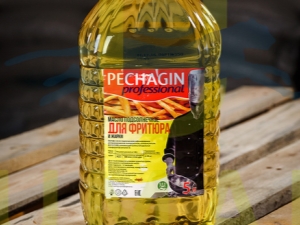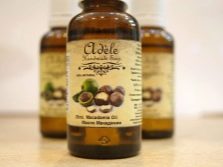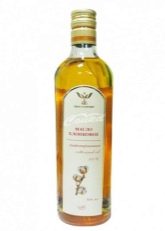How to choose and use frying oil?

Deep fat is considered the easiest way to cook. Using the right technology, the finished food comes out delicious, with a beautiful presentation and a crispy crust.
What it is?
Oil for frying in deep fat is an oil or fatty base, heated to the desired temperature in which food is cooked. The word "deep fat" comes from France, meaning the method of cooking products in hot oil. The Japanese call it "tempura." In Russia, this method appeared in the XVIII century and was called “yarn”, when the products were fried in a small amount of butter in a pan. The nutritional value of the product consists of a set of useful substances of a product prepared in oil.
100 grams of deep-frying oil contains vitamin E (24 grams) and fatty acids such as:
- saturated - 16 grams;
- polyunsaturated - 43 grams;
- monounsaturated - 40 grams.
How to choose?
It is necessary to choose oil for a deep fryer from the high-quality vegetable refined oils. From the right choice will depend on the quality of the food. Fried foods, contrary to popular belief about the dangers to health, still have the following useful qualities and properties:
- fried potatoes are enriched with tocopherol and coarse fibers;
- high temperatures of boiling oil can significantly reduce the time of cooking with the preservation of almost all vitamins and minerals;
- food tastes are improved;
- food is additionally saturated with healthy fats, which are a source of nutrients.
Cooking in deep fat also has a number of features, including high caloric content of the finished product. This should be considered for persons with increased body mass. The main parameter when choosing a base for deep-frying is the point of smoke (boiling point). It directly depends on the properties of the product, its composition, as well as the production technology and the totality of all additives. Traditionally, the highest heating point is the one at which the oil smokes, while the oxidation process takes place, which has its own characteristics.
If the oil boils for a long time, its beneficial properties evaporate, the boiling point shifts, and the amount of carcinogens increases. With prolonged exposure to temperature, harmful compounds are released from the composition, it acquires an unpleasant odor and bitter taste.
It is better not to use it or buy products, the point of smoke from which is much higher than it should be in fact. It is rather difficult to maintain the required temperature during the preparation period; a special skill is needed here. Beginners best to stock up on an additional portion of it. The stability of maintaining the desired temperature is achieved through the presence of saturated fatty acids in the fat: the more of them - the better the process of interaction with oxygen occurs during heating and, therefore, the better the prepared food will be. The main criterion for choosing a product is also proper cleaning. Fry in deep fat can only be on a purified basis, which has almost no color or smell.
Contrary to popular belief, it is possible to fry products on animal fat: pork and beef, as they are record breakers in the content of acids that support the desired properties of combustion.
It is worth considering some types of oils that are suitable and unsuitable for deep-frying.
- Ghee (or as it is called - ghee) get by melting the usual creamy. It turns out a useful product, free from protein impurities and lactose. It has all the necessary qualities: high presence of saturated fatty acids (66%), boiling point - up to +253 degrees, and resistance to high heating temperatures. It is used mainly for the preparation of dough products or frying in batter. Such a product can be purchased in finished form or made by yourself. To do this, simply melt the butter from the cream.
- Olive oil also used for cooking products in deep fat. Some of its types are most suitable, others not. It all depends on the properties and purity of the product, as well as the amount of polyphenols, which prevent the oxidation process.100 grams of olive oil contains: saturated fatty acids - 14%; monounsaturated - 74%; polyunsaturated - 12%. Depending on the quality of the product, the boiling point ranges from +200 to +245 degrees. Especially appreciated product marked "extra". It has thermal stability, has a high boiling phase with temperature retention, therefore it is suitable for deep-frying.
- Avocado oil akin to olive oil due to the presence of oleic fatty acids. It has a pleasant delicate taste with a nutty aftertaste. It has a high boiling point (up to +270 degrees) and passes to prepare deep frying dishes. Avocado oil is one of the most useful products for humans, as it has a beneficial effect on the heart and blood vessels. In the free market it is rare, but if you try, you can find it in finished form in the store.
- Macadamia oil - This is a foreign product that is even less common than avocado oil. The high price is justified by the excellent taste and quality of the product. In terms of fat content, it is similar to olive. The boiling point is +220 degrees.
- Coconut oil It is considered one of the sustainable products for deep-frying. Today it is the most popular type of oil. Special demand is unrefined oil, which consists entirely of saturated fatty acids. True, pure coconut fat has a higher point of smoke - +205 degrees.
The least useful oils are the following:
- flaxseed oil, containing a considerable amount of omega-3 and polyunsaturated fats (69%), which oxidize when heated and secrete carcinogens;
- peanut butter, containing 35% polyunsaturated fat;
- palm oil due to the low quality of market products, although in itself unrefined oil or orange palm oil is very useful, has a high smoke point, consists of saturated fats, but its cheap counterparts are very dangerous;
- cottonseed, mustard, and rapeseed oils due to their toxic erucic acid content; Many manufacturers have abandoned this raw material, since the technological process of purification from harmful impurities is too expensive.
Summing up, it is necessary to identify the main criteria for choosing frying oil. It is necessary to exclude products with a high content of polyunsaturated, omega-6 and low in omega-3 fatty acids, as well as with a high rate of trans fats. These include sesame oil, grape seed oil, corn, rapeseed, soybean, safflower and some types of sunflower oil.
How to use?
Cooking with the use of deep fat is considered to be a fast-cooking kitchen. It cooks meat and fish dishes, as well as vegetables and other products. The fryer itself resembles a vat with an internal grid, where products are prepared in a state of stable frying in oil of the desired temperature. The main requirement is a large amount of oil. It should be enough to completely roast the food. You can use a small amount of frying base, but then the pieces will need to be constantly moved from side to side. For cooking small pieces use a special grid for frying. Slices of food are placed in it, for example, potatoes.
Before cooking, it is necessary to warm up the fryer to get rid of protein residues on the walls of the dish. To prevent this, it is best to use refined purified fat. Frying oil should have a transparent consistency, without impurities and turbid inclusions.
It is important to achieve the right temperature. If the oil is not heated enough, the food will soak in it, and if it is overheated, it will be cooked outside and not fried inside.
Before cooking, you need to lower a piece of food into the deep fat fryer and check it. If bubbles form around, it means you can run products.
Frying oil is used repeatedly - up to four times. Before each subsequent use it is cleaned and filtered through special devices.If there are none, an ordinary gauze layer is suitable. Products in hot oil dipped using a special skimmer or mesh for products. The food is cooked quickly and has a beautiful neat appearance, which makes this cooking method indispensable for fast food and restaurant cuisine. Cook in small portions, folding the finished dish in a colander or on a napkin to remove excess fat.
Traditionally, the composition for deep fat consists of pork and beef tallow - in equal proportions. Experts prefer to add a little baked cow butter. But most often they use a homogeneous mass of plant origin, refined and purified from any impurities. This product is almost neutral, has no taste, no odor. The food cooked on it retains all its valuable taste and characteristics.
How often to change?
Used oil is used up to four times, but professional chefs advise you to change it after each call. Used product loses its properties and quality, it becomes bitter. In addition, the frying temperature is significantly reduced, and harmful compounds are formed in the product itself. In every cafe, restaurant or catering point, oil change should be carried out in accordance with the approved rules. Most often this happens once every two days with an average load on the fryers, in some cases it is changed every day.
In good restaurants you will never be served a dish fried in oil, reused.
Some doctors say about the dangers of products prepared in deep fat. In fact, the harm and benefits of food in oil are directly dependent on its quality and the technology of preparation of a particular product. You will not first begin to fry fish, and then on the same composition - donuts. Undoubtedly, there are elementary rules, the knowledge that is worth everyone who deals with deep fat, namely:
- under no circumstances should you pour oil into hot dishes, as it may ignite; if this happens, you need to try to extinguish the flame with a rag and other improvised means, turning off the stove, you should not fill the fire with water, otherwise everything can explode;
- food, before frying, must be dried from moisture, then it will not “shoot”, and the food will be fried all over;
- only deep-thawed products need to be deep-fried, be sure to dry them;
- do not fry on a hot, hot basis, otherwise you can spoil the food;
- it must be filtered before re-using it, experts also advise adding a few drops of lemon juice before further use;
- in case of contact with metal, oxidation occurs; therefore, the product should be stored in a dark glass jar with a tight lid and away from the sun's rays;
- it is better not to cook on an unrefined basis, since it smokes when it is heated and releases harmful compounds, and excess moisture and phosphorus compounds increase foaming.
Review of Alpoil Fryday Frying Oil, see below.



































